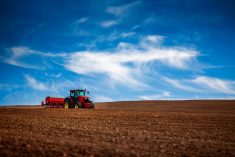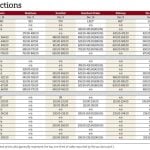We’re all tempted to roll our eyes and toss our hands in the air. All of us. This idea of self-assessment is so murky, after all. Or is it?
While most of us weren’t watching, provincial agriculture ministries have designed tools that appear to address the “so what?” question plaguing assessment. In theory, by rating yourself with these new tools, you can then get help to develop a plan that will actually improve your business management skills.
Even better, it will give you access both to the training or consulting services you need to get there, and to the funding to help pay for it.
Read Also

Winter downtime: Organize your farm records now for smoother operation
How to organize farm finances paperwork
Most of these programs fall under the new Growing Forward initiatives announced by Ottawa with the provinces and territories. Most are so new there is no data yet on their effectiveness.
So… in the pursuit of all that is good for COUNTRY GUIDE readers, this reporter persuaded (“coerced,” he says) her husband to engage with her in “TAKING STOCK,” a self-assessment handbook designed under the Farm Business Development Initiative through Saskatchewan Agriculture and Food.
“In farm management, there are nine areas where a producer needs to have some skill level in order to enhance profitability and allow them to attain their business and family goals,” says Ken Evans, provincial farm business management specialist in Weyburn, Sask.
These nine Farm Business Management Areas were arrived at through joint consultations with producers, industry and other governments.
In TAKING STOCK, producers answer questions related to each area according to a stoplight colouring. Yes, it sounds a little juvenile, but it’s actually well-spelled out. Green is a strength, yellow a caution area that could use improvement, and red a weakness that requires some pretty specific action.
Each question is also rated as to high, medium or low priority. Then, at the end of each section, you review your answers to come up with your general assessment for that category.
Let’s wade right in.
1. BUSINESS STRATEGY:
This section asks do you recognize past successes and failures, how well your business is doing, your purpose for farming, your farming and family goals, and whether you know when you’ve reached those goals?
To score a green in this area you have to be able to say, “Our farm or ranch business has a vision and purpose. We have a formal written business strategy that is reviewed annually. All members of the management team agree to the short and long-term goals for our farm business. Business goals align with family goals. Our day-to-day actions are directed by the agreed upon goals.”
My husband and I scored a yellow caution. We know our goals, but are they written down and consistent with family goals, well… perhaps that’s a stretch.
Ken Evans argues that, “although it’s seen as a soft objective this is one of the most important business management areas, since it flows into all the other areas.”
Consultant services and facilitation by professionals such as farm business advisors are often used to address needs in this area.
2. MARKETING:
The appraisal form wants to know if we have a written marketing plan and the skill to make marketing decisions? Do we know our cost of production and how to apply it to determine pricing? Do we use market information and research?
Having sold our dairy interests five years ago, we’re still figuring out this grain marketing thing, so it was no surprise to score another yellow caution.
After living under a supply management umbrella for 20 years, it’s like stepping out into a storm!
“Depending on a farmer’s preference, they can take training in futures, commodity pricing strategies etc,” says Evans. “Or they can hire a business advisor to help.”
Maybe we’ll do both.
3. PRODUCTION ECONOMICS:
Now the assessment process wants to know if we keep track of our current levels of production, if we keep records, and if we use these records to improve production and profitability and plan our needs for new equipment, technology and delivery systems.
It’s a long list when you start examining your production savvy. Cost of production is a huge area of interest — knowing it, recording it, and using it in production and marketing decisions.
Evans says training in calculating and understanding cost of production is available through workshops. “Our goal is to be fairly
basic in regards to our training in this area,” says Evans. “Basic, but with enough calculation and analysis for those just learning.”
Mostly we found ourselves edging toward a green strength in this area. “But we don’t know our full cost of production on every single crop,” I say with raised eyebrows. To which my husband concedes with a shrug. “Well, okay that needs work. And an equipment replacement plan. Yeah, that’d be good.”
Part of this process is forcing yourself to be honest about your operation and your own abilities. And doing this together, whether with a spouse or corporate partner, ensures no one can dodge the truth.
4. HUMAN RESOURCES:
Do you have a plan? Clearly defined work responsibilities? Work-life balance? (To which of course we all simply laugh.)
When we were dairying in the heart of the oilpatch in southern Saskatchewan, it was impossible to compete for labour. Work-life balance? There was no such thing. At that time we would have rated this a high priority. Currently we scored a red weakness in this area but we also marked it as a low priority. Ironic!
“Training or the use of consultants in this area is becoming more and more applicable, especially on larger livestock operations or with older farmers planning for succession,” says Evans.
5. FINANCIAL MANAGEMENT:
Do you consider your business financially successful, pay your bills on time, have a record-keeping system, know your net worth and make decisions with tax implications in mind?
If you answer yes to all of these you score a green strength in this area. But for the fallible among us, there is help available through training, workshops, or professional advisors. “It can be as simple as hiring someone to assess the effect of acquiring another half-section of land,” says Evans. “Or training and education on reading financial data so… I understand where my balance sheet sits.”
6. ENVIRONMENTAL STRATEGY:
Is your environmental farm plan in place? Do farm practices promote environmental stewardship? Are your products traceable?
Most training has been done around the environmental plans, says Evans. But he sees new concepts — such as the application of carbon credits in agriculture — emerging as an interest area for farmers.
7. SUCCESSION PLANNING:
How’s your will? Updated every five years? Is there a contingency in the case of untimely death, disability, divorce or any other big d’s? Is your succession plan written out? Have you looked at tax issues? Plans to treat all your kids fairly? Is your business structured to facilitate succession? Whew!
This is by far the number one identified need area, according to Evans. Consulting and training workshops raise awareness of the importance of succession planning and the processes involved.
“For the legal and accounting aspects, you should employ professionals like lawyers and accountants,” Evans says.
No kidding. At our stage, my husband and I consider this both a red weakness and a high priority. We have four teenage kids, one already off to university. So we’ll have to shake ourselves from disbelieving stupor and get on it!
8. BUSINESS STRUCTURE:
Does your legal structure meet the goals of your business? Are there written agreements? Do you know who owns what?
“Many people assume they should go directly to the accountants and lawyers when they first decide to incorporate,” says Evans. “But accountants lock in on the tax issues.
There are a host of other things to consider, like how the share structure will affect future plans or does this structure fit with my goals.
“We’ve developed a bit of a checklist to make sure all areas are being addressed, and to help individuals ask the right questions when they do go to their lawyer or accountant.”
9. RISK MANAGEMENT:
Do you have a plan for production risk, market risk, loss of labour or management skills? Can you measure financial risk? Have a plan to deal with policy changes? Are your investments diversified?
Oh, we are so yellow. It seems impossible to be prepared for every eventuality.
This sentiment is reflected in the relative lack of uptake in this area, Evans says.
“But what-ifs come up quite often,” he adds. “Look at the flax issue now, or BSE. They all filter back to the primary producer and as much as possible, the producer has to be ready for them.”
It’s a lot easier to go to the bank if you’ve had a crop failure and you can show them how you plan to survive it, he says, adding much of this area can be addressed through consulting services, the wise use of government programs, and insurance.
So that’s it! These are the nine Business Management Practices required to survive agriculture today. We discovered we’re doing okay. We confirmed there are areas we can do better. Now the hard part. Doing something about it.
Ideally the assessment should next be taken to a regional specialist and a farm development plan should be completed to identify priority areas and determine which can be addressed through producer training and education and which would be better handled by outside consulting or advisory services. This is then submitted with an application for funding.
In Ontario virtually the same assessment is used. (Saskatchewan acknowledges it’s modified their handbook from the original out of Ontario). The Ontario assessment is done in two-day workshops.
Six pilot workshops were held in August. “Farmers here find good value in hearing what others have to say and how they deal with things,” says Mike Terpstra, program manager for Growing Forward, Business Development for Farm Businesses in Ontario.
There are 40 more scheduled workshops across Ontario continuing into December.
“Producers get a good background on what each question is about and a higher comfort level with answering them,” Terpstra says. “We give them homework on the first day so they can go and discuss the questions and come back knowing where they’re at.”
Participants take the assessment from the workshop and develop goals and action plans around it, says Terpstra. They then meet with a workshop leader to refine the plan, the leader signs off on it and then matches them up with training and cost-sharing opportunities.
Similar assessment — planning — training — funding programs are in place in Manitoba, the Yukon and British Columbia. Check provincial government Growing Forward programs for information in your area.
Other agencies have self-assessment tools, including the Canadian Farm Business Management Council and the Centre for Rural Leadership Farm Choices program. There are probably more and they’re worth checking out. Just ask my husband. CG














